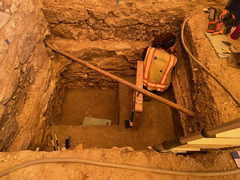The archaeologists from Raba Kistner continued to excavate in excavation unit (EU) 9b and 3. Unit 9b is located on the south side of the Long Barrack, whereas Unit 3 is located on the south side of the Church. In addition to the excavations, the archaeologists were working on completing the end of excavation documentation for Units 1, 7, 8, and 19.
Archaeology Update — Cobble Stone Mapping In Unit 9B
On the south side of the Church, the archaeologists reduced the larger 2-x-2 meter unit to a 1-x-1 meter unit to expose the juncture of the two walls. The reduction in size allows for the archaeologists to safely continue excavations as the depth of the unit requires benching. Excavations by the end of the week reached approximately 66 inches below datum.
The archaeologists have not encountered the base of the foundation and will need to continue excavations the following week. Few artifacts are being encountered in these lower levels, and consist mainly of snail shell, a few lithic flakes, and a couple sherds of pottery.


Within Unit 9b on the south side of the Long Barrack, archaeologists had previously reduced the footprint of the unit to not impact or undermine the large PVC storm drain. What the archaeologists have uncovered in this unit provides some interesting information concerning the construction of the Long Barrack.
A shelf of caliche and some stone, as well as the location of a post hole, abuts the foundation of the structure. It was thought that this shelf was representing a kick-out similar to what had been seen on the interior, but excavations have revealed that there is only one course of this caliche and stone matrix, with dark soils beneath. A portion of the shelf would need to be removed to allow the archaeologists to expose the foundation stone.

By the end of the week, excavations had reached a depth of approximately 51 inches below datum. During the excavation of the last level of the week, the archaeologists began exposing cobbled stones. These stone locations are being mapped, and the stone then removed to see if this is the beginning of the bedrock that had been observed in other locations.
In the unit located on the interior of the structure, opposite of Unit 9b, cobbled stones were encountered just above the bedrock. Excavations next during the following week will help determine if the archaeologists have indeed reached the bedrock.
Once these last two units have reached their terminal depths, there are no more planned excavations at this time. The archaeologists will be able to take all the data they have collected to date, and begin analysis in a effort to better understand the archaeological record at the site.


